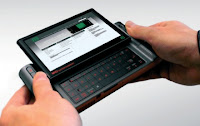The affordable "digital pencils"

Thirty years after I first took my first personal computers from Commodore (the PET), Radio Shack (TRS-80) and Apple (the Apple II) into my elementary classrooms in Wisconsin, we are almost there, finally close to realizing the dream of a new public school curriculum built on the metaphorical digital pencil (e.g., affordable, networked, every child has one in the classroom, personal computer). For example of price movement in the right direction, see EB's simple MIMD prototype to the left or explore Gillette's excellent chart comparing the current leading low cost laptop computers, which does not include the Elonex One (100 UK), Northec Gecko ($300 and up), or the more than 25 new Intel Atom processor devices ($250-$350) coming soon.
It took the recent threat of Nicholas Negroponte's $100 XO laptop vision for the computer industry to "get religion" on the topic of functional ubiquitous child-priced computers. The industry then shifted close to panic this January as Mary Lou Jepsen (past CTO for Negroponte's XO project, now head of Pixel Qi) promised a $75 device in large quantities by 2010. She can deliver and they know it. Though fearful of cannibalizing older product genres, the current hegemony of digital power is wisely recognizing self-interest in the creation of an entirely new product category. New low-power, cheaper chips seem to be announced almost daily from the chip foundries like Intel, who are hopeful of a new computer-rush.
This hopefulness is generating a bit of interesting spin-master product placement fantasy. Educators be alert! The labels of $100 laptop or OLPC or XO have been awkward, so new terms are emerging, including "Handheld-size MIDs,--short for Mobile Internet Devices and Netbooks" (Crothers, 2008). Intel and other major corporations would like to sell the concept to schools that though the inexpensive devices will have cheaper and slower CPUs, the cheap MIDs and Netbooks will be at least great information delivery devices, Net readers if you will. Embedded in their pitch is the impression that the larger more expensive software applications and computers will still be needed to do the real work, the creative composition of the world. How protective of the status quo sales of expensive laptops and so belatedly Web 1.0. Whoa - did they sleep through all the million news stories on Web 2.0 over the last three years? Do they have any idea how big the set of online applications has become which is competing with desktop applications? Since dirt cheap laptops are heading into the market, doesn't IBM look brilliantly prescient having sold their personal computer line to Lenovo in China years back?
Shades of the time-share terminals of the 1970's, the hardest computing is getting done on the networked server, not on the laptop. The creative compositional/editing work from text to photo to music to video is increasingly getting done on IBM's "big iron" mainframe style computer with the web browser serving as the operating system for the computer as remote terminal. This transition gained huge momentum with the text blogging movement, a technique that I am using now to enter text into an input box on a web page for this editorial. That is, we increasingly don't have to have expensive software such as the Microsoft Office apps or Adobe Premiere which require expensive high speed laptops and desktops in order to do compositional work. Also we don't have to have a printer. All we generally may need is a web browser to reach composition tools and the Net to publish the creations.
There is a further and much greater educational affront than failing to develop computers priced for every child to have in schools. This is the corporate computing concept undergirding "netbooks" marketing to schools that classrooms are information delivery vehicles ("open brain, pour in information, now even faster and cheaper with a Netbook!"). Want to compose something? Buy the more expensive technology." Such "worst practice" models should be stamped out where ever they rear up. Especially in a democracy, literacy should mean both reading and composition, the capacity to understand AND create what goes on a page (cellulose OR digital). To a certain degree, a cheap Netbook or MID will do both just fine, thank you, and with a browser to reach online applications, can do so at a level appropriate for K-12 to introduce the full range of 21st century online composition/editing: text, photo/drawing, animation, audio, video, 3D, and electronics.
Moore's law and other trends will eventually make the cheap $75 computer as powerful as today's expensive laptops. So, watch carefully for new sightings of the products noted above and others that might emerge. Post your comments and finds here. Good news - within the next two years, public education will be able to fully enter and embrace the 21st century and its new literacy requirements and in large measure, obliterate the cause of the digital divide. If legislatures finance appropriately, public schools can do the rest. Are we ready?

Comments